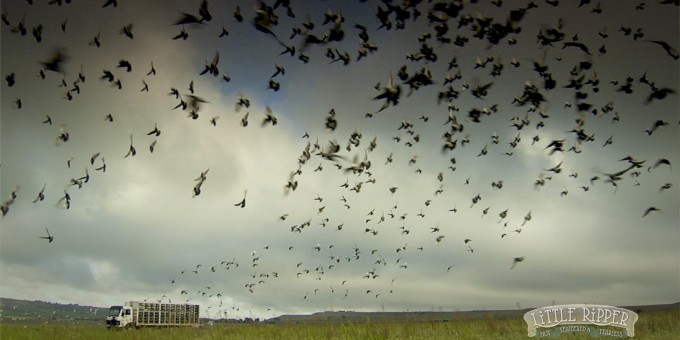
You can listen to the Office Hours interview with Colin Jerolmack here.
“Pigeons are believed to be the first domesticated bird and perhaps one of the first domesticated animals—between five and ten thousand years ago. There’s a lot of things they’re useful for,” says Colin Jerolmack, author of The Global Pigeon. He goes on to explain that pigeons were once prized for their meat and eggs, their guano (which made an excellent fertilizer), and their famed homing ability. Now, when cheaper, fatter chickens have replaced them at the dinner table, nitrogen has ousted guano as the world’s preferred fertilizer, and all manner of technology has made the flying missive obsolete, they are essentially urban rats of hundreds of breeds. “So what you have is birds who actually thrive around people in the built environment—better than they ever did in their native habitat. They’re thriving, but they’re kind of ‘historical detritus.’” And now, Jerolmack asserts, pigeons confront us as nuisances, adding a chaotic, “dirty” element to the pristine, manicured presentations of nature modern urbanites prefer. “They trespass in places defined for humans only.”
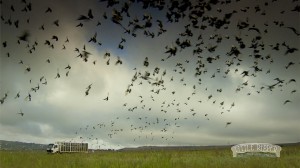
The Society Pages talked to Jerolmack about how he came to lavish so much scholarly attention on an animal most people seem happy to shoo away.
Kyle Green: I’ll start with the obvious question, “Why pigeons?”
Colin Jerolmack: When I was a very early grad student, I think in my second year of grad school, I took Mitchell Duneier’s ethnography class at the City University of New York. We had to pick a project. I knew I was vaguely interested in public space [so] I focused on a couple of parks in Greenwich Village… I thought looking at a space that was going to be renovated [would] give me an opportunity to see how people use public space, what their dreams and hopes for it are. Whose vision wins out, who loses, who’s seen as legitimate stakeholders? And so I started hanging out in a lot of these parks and going to community board meetings and talking to block associations and everyday visitors.
One of the things that I really hadn’t anticipated was that a major talking point, point of concern… was pigeons, particularly in a place called Father Demos Square, which is quite small (less than 1/10 of an acre), yet has hundreds of pigeons. [P]eople feed them regularly. [But] …the city was cracking down on pigeon feeding and issuing nuisance citations. And when I was talking to a lot of people about problems with the park, many complained about pigeons and homeless people the same way. They would say: If we could get rid of these pigeons and these homeless people, wouldn’t these be great public spaces? There was this connection between pigeons and homeless and this sense that pigeons were dirty and filthy and somehow symbolize disorder.
As I started writing up some papers about these urban spaces for the ethnography class, I said, I can’t really write about these spaces and how people experience them if I don’t write about pigeons. So that’s kind of how it started.
…What made me decide to move forward with an entire project about pigeons was paying more attention to—I lived in Bushwick, Brooklyn at the time—and from my rooftop I would see six or seven stocks of pigeons, hundreds of them in each stock, circling. And I knew that these were bred by people. I knew about this working-class kind of male subculture, because it has a long history in New York. … And so I kind, out of curiosity, started to get to know [breeders]. Once I realized there was this really fascinating story both about how the men experience the urban ecology through their birds and how this was traditionally an ethnic white practice (passed on to Puerto Ricans and blacks as the neighborhoods changed over), that’s when I thought there was a lot I could do.
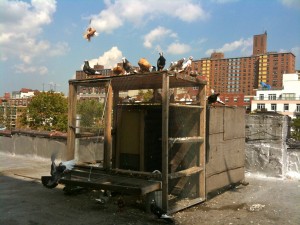
Green: Your book is organized into three sections: the pedestrian pigeon, the totemic pigeon, and the professional racing pigeon. In the third, you followed two rather different racing communities. Who are these guys in the Bronx who first captured your curiosity?
Jerolmack: The guys I talked about in the “totemic pigeon” portion of the book, they’re not racing pigeons. They basically just breed [rooftop fliers] and train them to fly in tight-knit stocks… like a swarm of bees, if you will. It’s the pleasure of training the birds to fly as a unit and, if they’re lucky, they catch other people’s pigeons, their stocks mix…. But pigeon racing… the idea here is to use the homing ability of pigeons. You can take them to a place they’ve never been and through their ability to sense electromagnetic radiation, see ultra-violet light, and use the sun as a compass …they can find their way home.
The idea here then is that … in the Bronx these men can put their pigeons on a truck and the truck can drive to Virginia. Then the pigeons can fly home four to five hundred miles and generally do it one day, a single day. [The winner is] the fastest pigeon measured by yards per minute (its velocity). So there’s a measurement from the starting point to each racer’s coop, where the birds are released. Everyone has exact GPS measurements.
To race in the club [I studied], you have to be within the borders of the Bronx. This necessarily makes it a parochial club… men have grown up and stayed in the neighborhood, and, in most instances, their fathers and even grandfathers were members of this club. …Generally it’s men and almost all of them are working class, although they tend to be a little bit higher economic status than the rooftop fliers. …Pigeon racers have to train the birds every morning, drive them 50-100 miles away, which costs a lot of gas money. There’s race entry fees and whatever, it costs more money. Generally the modal (or “typical”) pigeon racer has retired from a city job (sanitation, policeman, fireman), they’re blue collar union people. Like the rooftop guys, [it’s] a variety of ethnicities, older people, ethnic white, but there also were a number of Hispanic and African American men involved.
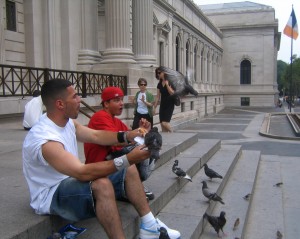
Generally they gather at the club, hang out, drink coffee, and watch the Yankees if there’s a game on. Then they pack their birds in a truck and it drives off to Ohio, Virginia—wherever the race start is. The next day, the men wait on their rooftops for the birds to come home. When the birds fly home, their time is clocked when they come into the coop [because] there’s an electronic band on their leg that is scanned by an electronic clock… So sometimes when pigeons come home, they sit on the roof or fly around for a while. The guys can lose valuable time, so they wait on the rooftop and devise all sorts of strategies to bring the birds home [and into the coop]. They may bring out their mate… they have various strategies. And then they bring their clocks back down to the club and see who won.
Green: So, pigeon racing requires large amounts of time, at least some money, and what seems like a good amount of emotional energy. What is the seduction or appeal?
Jerolmack: You know, that’s the question I struggled to answer. The things I think immediately spring to mind are competition and money. People like to win, people like to compete… and there is some money laid out for bets [and prizes]. But what I try to argue in the book is that it cannot be reduced to competition or money. Most men wager very little money and most men break even at best. The goal is not to be in the red by the end of the racing season, not really to “clean up.” And so I really tried to go deeper into what is it that compels these people, and this what I love about ethnography, the only way you can really discover this is to be there and participate in it.
And so what I argue is that pigeon racing offers an opportunity to really engage, to personally invest and engage in nature vs. nurture. So you take these birds, you breed them, and then you train them. So what all this is about is trying to control nature, to get the perfect breed and then through training … [to] bring the birds home quicker…. You try to unlock the secrets of nature and use them to your advantage.
But on the other hand, there’s all sort of elements that [racers] can’t control. Once the birds are in the air, as one guy said to me, “They’re in God’s hands.” There’s all sorts of things you can’t control… so you kind of open yourself up to the vicissitudes of nature. When your bird comes home, it’s kind of this triumph over nature. …[E]very time it comes home, it really is kind of as magical as it seems to the person who doesn’t know a lot about pigeons. When [the racer] sees their bird come over the horizon, even if the bird doesn’t have a chance for first place any more, their mouth gets dry, they start shaking, the adrenaline is rushing. And when the bird comes home there’s this sense that they did it. They beat the odds, they triumphed over nature.Green: So, am I right that the men you met in the Bronx didn’t see pigeon racing as a way to enjoy nature, but as a triumph over or struggle against it?
Jerolmack: That is a fair characterization …when I first started hanging out with these guys who fly pigeons, my romantic idea was that this was their cabin on Walden pond, their escape from the concrete jungle, their opportunity to bond with nature. What I found instead [were] men, men who in general had no other interest in nature. They didn’t camp; they weren’t interested in forming relationships with nature, more generally. They didn’t see it as an escape, it was more that they went to the rooftop with little bits of nature’s raw material and delighted in their ability to sculpt it according to their own whims. But what I will say—this is important about ethnography—I didn’t come up with this argument …by the men telling me “I like to triumph over nature.” Rather it came from me observing the way they talked about pigeon flying and what they actually did.
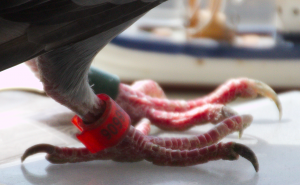
For instance, I talked about how the men obsessed over all types of strategies… trying to unlock the secret of genetics or weather predictions …Ways that they would try to sort of wish for a better outcome. And if their bird came home though a storm? That was about as exciting as it gets. …That’s what led me to this argument. Very few of the guys said, “I like controlling nature,”… but it was what came out of me observing their more natural conversations and their reactions to seeing their birds come home.
Green: Let’s go to South Africa now. What is the Million Dollar Pigeon Race?
Jerolmack: So the Million Dollar Pigeon Race is a race where the winner gets, when I last checked, $200,000. The second place winner gets $120,000 and so on down the line. The total payout is a million.… I went to the Million Dollar Pigeon Race in Sun City (the South African equivalent of Las Vegas) because the guys in the Bronx were talking about it and it’s the biggest of the one-loft races. A lot of the guys in the [Bronx] club sort of saw [the Million Dollar Race] as the antithesis of the “craft”: …you send your bird there and somebody else raises it, somebody else trains it, and when it flies “home” you aren’t up on the rooftop corralling it in….You’ve outsourced it to somebody else.
People from around the world, from 28 countries sent pigeons…. If I wanted to, there are people who will sell shares of a bird… So Sun City brings all sorts of people who are not pigeon racers. Just like the Kentucky Derby, you can bet on a pigeon.
It was bizarre after waiting on the rooftop with the guys from the Bronx. In South Africa, we all sat in a stadium arena and there was this Jumbotron. …You’re not allowed to be at the pigeon loft to watch, because it may scare the birds coming in. And so we basically sit there in an arena, thousands of us, waiting for the pigeons to come home on a video screen. Everybody’s put money down. When the pigeon comes down, they walk across the threshold and it comes up on the video screen who the winner was.
…[T]he race only takes one day… Again it was a big commercial affair, in the stadium they had all sorts of vendors selling all sorts of pigeon magazines or Million Dollar Pigeon Race gear. There was a restaurant set up so you could by food. …[P]eople hung out with other pigeon fanciers and they had guest speakers. People who were famous in the pigeon world talked about their techniques. They had a band entertaining people. But then, about two to three hours before the birds might come in, it really started to fill up. You never know: if the wind is to their back, maybe the pigeons will come home really quickly.
Green: Writing about the Million Dollar Pigeon Race, you drew on the writings of the famous anthropologist Clifford Geertz to talk how the event serves “as a story society tells about itself.” What does his essay about “deep play” and Balinese cock-fighting have to do with pigeon racers?
Jerolmack: Geertz shows how …there are all sorts of rules about who you can fight against and who you can bet for or against. These reflect the social hierarchy of society. …I find that [observation] useful. …There’s all sorts of things that can be said to be cultural representations of a society. So the question here is: What does the Million Dollar Pigeon Race tell us about South African Society and globalization?…What I found really compelling was that in South Africa, this is a country still coming out of the shadow of apartheid and looking for ways to tell itself and everyone else that it is a diverse, democratic, and colorblind society. … The men [I met at the Million Dollar Race] who self-identified as “Colored” or Black* told me… they could recall an era where of course they were not free, under apartheid, but they’d raise pigeons back then. And so they were very insulted that there were separate clubs for whites; even if they had the best birds in their club, they were never able to prove they were the best in South Africa… Through the Million Dollar Pigeon Race, they very clearly narrated this as, “Here I can come now, and I can go up against anyone in the world and …prove that I am the best of the best.” For them there was an opportunity to recognize that, although there were still racial barriers and discrimination in South Africa, …a meritocracy had actually flourished in the Million Dollar Pigeon Race….

The organizers of the race didn’t explicitly talk about apartheid at all, but they repeatedly emphasized the equality of the race, the equal opportunity, that this is a true meritocracy. That anyone has a chance to beat anyone. That people from around the world, no matter their station in life, have the opportunity to come and compete here.
This also plays out in another way…. Though you pretty much have to have a fair amount of money to go in this race, there are some relatively blue-collar people who may put in one bird. So they’ll put in a thousand dollars, in the same way you might enter Powerball, right? Put in a little bit of money, very little chance to win, but you have a chance. I’d meet these blue-collars guy who would say “You know, the Queen of England has pigeons in this race,” which is true. … And so that was very powerful to people, right? So very much there was this really strong feeling of egalitarianism and meritocracy that, on one hand, I argue really sort of rang true and was deeply meaningful in South Africa, given the legacy of apartheid. But on the other hand, it very much rings with the sort of neoliberal idea of globalization and a flat world. Like, people said, “Now we’ve broken down the barriers and people can compete against everybody. Everybody has an equal shot.” There is a sort of feel good story about globalization and how it levels the playing field.
Green: Before we were talking about that underlying tension in the relationship between the social and natural or the urban and the wild. Is this different in the Bronx versus in South Africa, in the big-money races?

Jerolmack: …I play on the tension between the Bronx Club and the Million Dollar Pigeon Race. [In the Bronx], the idea is that you hope to triumph over nature…. So you actually have to make yourself vulnerable to being taken in and overwhelmed by nature. And then when you win, you feel that you’ve taken steps through the craft to kind of unlock the secrets of nature.
… [I]n South Africa there’s no room for idiosyncrasy, there’s one way to do it—whatever the veterinarians and the peer-reviewed literature say is the best way. And so it’s very much scientific, it’s very much the triumph of science over magic, if you will. It is the classic Weberian story of disenchantment …through the division of labor.
Green: To conclude our discussion, I wonder, what did the research project teach you about the discipline and how we actually go about studying the social world?
Jerolmack: …[S]ociology, I’m happy to say, is a very diverse, open discipline. …My job [is to] demonstrate that relating to animals teaches us something about the traditional things that we scholars care about: community, identity, race, gender, class.
…[M]y goal has always been to …show how our relationships with animals actually organize and shape our relationships with other people. [Now] I’m researching fracking and how it’s influencing communities in rural Pennsylvania, but it’s related to this broader interest [in] how much the nonhuman (whether that means the built environment or the natural environment or animals) is actually the sort of scaffolding that organizes society.
*South African respondents capitalized their racial categories.

Comments